Abstract
Assess the risk of LNG fire of LNG fueled ships navigating in the middle reaches of Yangtze River of China according to the acceptable risk criteria so that support technically to design, building and shipping safety management of LNG fueled ships and also to marine safety administration. “Fault tree analysis” was used to analyze the contribution of factors for LNG fire of LNG fueled ships. Statistical analysis base on the Normal distribution was carried out to reveal the confidence intervals of the probability of ships collision, touch and general fire. Quantitative assessment showed that LNG fuel is not suitable for passenger ships and chemical cargo carriers. It was found that ship length is the key to people onboard evacuating in case of LNG fire, so that LNG valid volume above 20M3 was unsuitable for a ship with length less than 80 m as well as that more than 10M3 was very dangerous for crew onboard a ship with length less than 45 m. Factors of bridges over river, berths along banks and anchorages in river, which would aggravate the consequences of LNG fire, were taken into consideration during risk assessment. In view of navigation condition in the middle reaches of Yangtze River, measures were suggested for LNG fire risk control of LNG fueled ships.
1. Introduction
As a clean energy to substitute fuel oil, liquefied natural gas (LNG) for shipping power has broad prospects in “the green developing” of Yangtze River. Presently, there have been more than 280 LNG fueled ships operating in the inner water of China and about 1000 are planning to build [1], which implies a potential appreciate market. With the rapid developing, risk control of LNG transportation should be strengthened due to risk raised highly. The high temperature of flame, strong radiant heat, rapid spread and huge mass burning rate of LNG, make LNG fire very dangerous and too much difficult to extinguish. Furthermore, crowd navigating route, many bridges over river and limited space onboard ship, which would aggravate significantly people’s death or injure and property loss in an accident. Therefore, fire should be a primary object of the risk control of LNG fueled ships. Vanem E. analyzed the risk of LNG carrier operations. Vianallo C. made quantitative assessment of gas distribution network in Italian. Guo researched the safety of LNG transportation in rivers of south-China. Wang assessed the quantitative risk of leakage accidents of LNG carriers in inland rivers of China. Dai indicated the probability of water pollution accidents forcing live water intake stopped in Yangtze River. Li put forward acceptable risk criteria of industries of China. However, the quantitative risk assessment (QRA) particular for LNG fueled ships has not developed. Considering the special arrangement onboard LNG fueled ships and fire requirements, a detailed QRA is necessary, which would provide helpful information and knowledge not only for design, building and shipping safety management of LNG fueled ships but also for marine safety administration.
2. The risk of LNG fire on LNG fueled ships (below abbrev. as LNG fire)
In this paper, LNG fueled ships are those ships operated only in the inner water of China including Yangtze River. LNG fire is the accidental combustion of LNG fuel caused by such basic accidents as damage of tanks, breakage of pipes, leakage of valves of the LNG system onboard, or the ship collision, touch, normal fire, etc. The risk of LNG fire is the product of the accident frequency and the accident consequence C, i.e. .
To analyze and reveal the relation between the LNG fire and the basic accidents of LNG fueled ships, “fault tree” is a typical method of analysis [2], as shown in Fig. 1.
Fig. 1“Fault tree” analysis of LNG fire
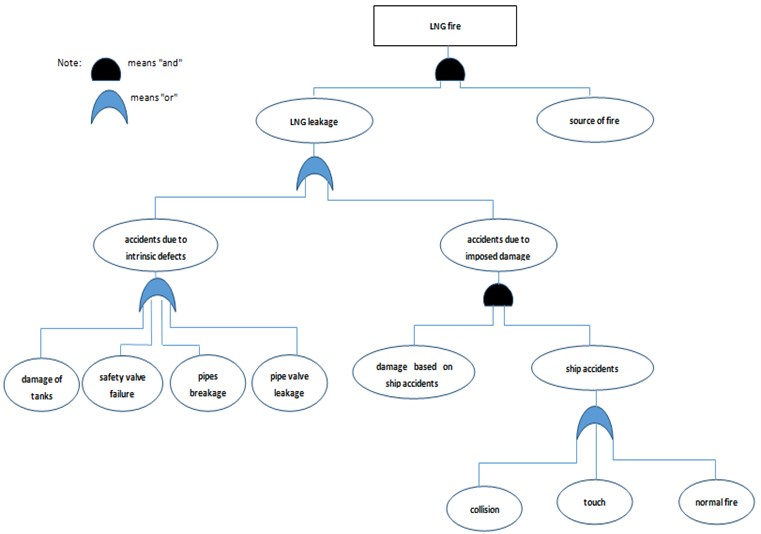
3. The frequency of LNG fire,
Based on the “fault tree” analysis, the frequency of the LNG fire is calculated by the formula as below:
In the Eq. (1), is the frequency of accidental sparks occurring on board a LNG fueled ship, usually taken as 0.24 [3, 4]. is the probability of basic accidents. is the probability of LNG leakage onboard caused by basic accidents.
3.1. The LNG leakage caused by damage of tanks, breakage of pipes, leakage of valves of the LNG system onboard. It is seen in Table 1 that the probability of such basic accidents as the damage of tanks, breakage of pipes, leakage of valves [5].
Table 1probability of such basic accidents as damage of tanks, breakage of pipes, and leakage of valves
Basic accidents | Damage of tanks | Failure of safety valves | Breakage of pipes | Failure of pipe valves |
The probability , / year | 3.0×10-6 | 9.0×10-6 | 3.1×10-5 | 4.4×10-5 |
LNG fuel leaked definitely in case of tanks damaged, pipes broken or valves failed, which means the respective probability 1.
3.2. The LNG leakage caused by ship collision, touch, normal fire. It is seen in Table 2 that data of ship collision, touch or normal fire happened during 2011-2018 in the middle reaches of Yangtze River [6, 7].
Data of ship collision in Table 2 is samples of statistic totality which generally obeys to Normal distribution. Because the sample average obeys to ‘-distribution’, the confidence interval with credibility level of the average of statistic totality u is able to be described as:
Table 2Ship collision, touch or normal fire happened in the middle reaches of Yangtze River (2011-2018)
Year | Navigating ships | Ship collision | Ship touch | Ship normal fire | |||
Collided ships* | Collision frequency | Touched ships | Touch accident frequency | Fired ships | Fire frequency | ||
2011 | 82976 | 182 | 0.00220 | 13 | 0.00016 | 7 | 0.00008 |
2012 | 81151 | 156 | 0.00192 | 11 | 0.00014 | 11 | 0.00014 |
2013 | 78718 | 132 | 0.00168 | 16 | 0.00020 | 8 | 0.00010 |
2014 | 80312 | 112 | 0.00140 | 9 | 0.00011 | 14 | 0.00017 |
2015 | 82064 | 112 | 0.00136 | 14 | 0.00017 | 8 | 0.00010 |
2016 | 87478 | 268 | 0.00306 | 33 | 0.00038 | 22 | 0.00025 |
2017 | 81869 | 214 | 0.00262 | 39 | 0.00048 | 19 | 0.00023 |
2018 | 82499 | 192 | 0.00233 | 23 | 0.00028 | 15 | 0.00018 |
*Note: the numbers of collided ships equal to the numbers of collision accidents plus 2 | |||||||
In Eq. (2), is the sample standard deviation, n is sample numbers, and is generally taken as 0.05. Furthermore, because the sample variance obeys to -distribution, the confidence interval with credibility level of the standard deviation of statistic totality is able to be described as:
For the above example, the average of ship collision frequency is 2.07×10-3, the standard deviation is 0.6×10-3. The confidence interval with 95 % credibility level of the average of pc is (1.57×10-3, 2.57×10-3) as shown in Fig. 2(a), and it is (0.40×10-3, 1.22×10-3) for the standard deviation of .
Fig. 2The confidence interval with 95 % credibility level of the average of pc, pt and pf
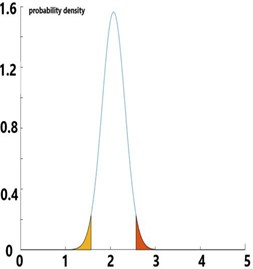
a)
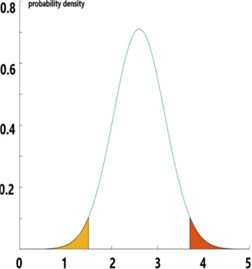
b)
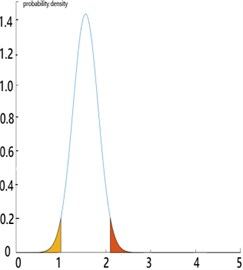
c)
In the same way, for the samples of ship touch accidents the average value is 2.6×10-4, and the standard deviation is 1.3×10-4. The confidence interval with 95 % credibility level of the average probability of ship touch is (1.5×10-4, 3.7×10-4) as shown in Fig. 2(b), and it is (0.86×10-4, 2.65×10-4) for the standard deviation of .
For the samples of ship normal fire, the average value is 1.55×10-4, and the standard deviation is 0.6×10-4. The confidence interval with 95 % credibility level of the average probability of ship normal fire is (1.0×10-4, 2.1×10-4) as shown in Fig. 2(c), and it is (0.40×10-4, 1.22×10-4) for the standard deviation of .
Damage of LNG fuel tanks, pipes or valves caused by ship collision, touch or normal fire. The research of inner water ships crashworthiness [8-10] claims that the colliding force between ship and rigid structure is connected with the ship tonnage and colliding speed. Approximately, the connection could be prescribed as below:
where is colliding speed, m/s; is ship tonnage, t; is a corrective coefficient, taken as 0.75 for a ship of tonnage less than 1000 t and 0.09 for a ship of tonnage above 1000 t but not more than 3000 t.
LNG fuel system onboard inner water ship is ordinarily located at stern, as a result it would be stroke at a low speed in collision. Tanks and pipes of LNG fuel system are arranged so carefully that any part of them is of the distance no less than 0.8 m to ship hull boundaries according to the present Regulations [11, 12]. Therefore, the probability of damage of LNG fuel tanks, pipes or valves caused by ship collision, touch, , is not above the level of 10-2.
LNG fuel tanks, pipes or valves would fail by massive heat in a normal fire onboard. At the level of risk protection according to present Rules, however, either the probability of tanks failure or the probability of pipes and valves failure is not above the level of 10-2.
LNG fuel leaked definitely in case of tanks, pipes or valves failed in ship safety accidents, which means the respective probability 1.
3.3. Uncertainty of the decision support system. As a decision system based on statistic data, there are inevitably uncertainties existed in natural variability of objects, imperfect of measuring, assumption of modeling, sampling, etc. For example, the history data of eight years is too finite to obtain a precise probability of shipping accidents totality, and then it has to accept some wider confidence intervals. The confidence intervals with 95 % credibility level of the average probability of , and , gave description of the uncertainties. Due to accumulating and transferring of uncertainty, its impact demonstrates eventually in the frequency of LNG fire according to the Eq. (1). Therefore, it is able to calculate out the uncertainty of the frequency of LNG fire which display as the sum of variance in the following process:
4. The consequences of LNG fire,
LNG fire appeared mainly in two ways: pooled fire and vapor cloud explosion. Different way is of different consequences [13, 14]. Setting {} as people death in pooled fire, and {} as people death in vapor cloud explosion, then the consequences of LNG fire is prescribed as . The calculation of {} is based on the heat radiation of pooled fire in which people suffered onboard. For {}, the basis is shock wave overpressure of vapor cloud explosion. Models and formulas of these calculations are omitted because of few connections with the subject of this paper.
5. Risk assessment of LNG fire
where is the calculated risk. , namely safety coefficient, is taken as 5 with considering that accidents frequency and consequences rise up with over-speed or overload of ship, flood, and intense heat of summer, strong wind, and damage aggravating if accidents happened in which bridges, ports or anchorages located.
5.1. Criteria of acceptable individual risk, . In the light of safely developing idea, it is determined that the acceptable individual risk of inner water shipping of China should not be lower than developed countries [15]. According to the guidance notes of IMO [16], the maximum acceptable individual risk of ship crew is 10-3/year, and the maximum acceptable individual risk of passengers onboard is 10-4/year.
5.2. Criteria of acceptable social risk, . Criteria of acceptable social risk of LNG fire, , referred to the “F-N” curve recommended by IMO [17], as shown in Fig. 3.
5.3. The risk of LNG fire is acceptable only if it complies with the requirement as well as lying in “acceptable area” or “as low as reasonably practicable (ALARP) area” of the “F-N” curve.
Fig. 3Criteria of acceptable social risk of LNG fire (F-N curve)
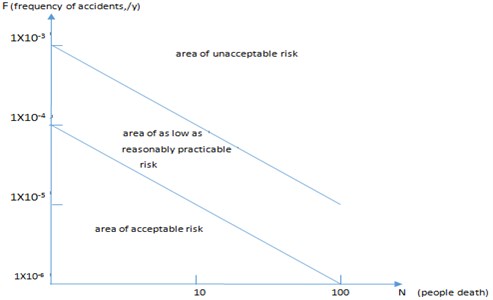
6. Measures and recommendations for LNG fire risk control
Yangtze River is the busiest inland waterway of shipping in the world [18]. Presently, the average tonnage of general cargo ships in Yangtze River is more than 1500 t [19], the average fuel consumption of a ship operating at economical speed is about 4.1 kg/kt·km [20]. It is necessary that 8 tons of fuel oil for one voyage of the ships. If it used LNG fuel, the liquid volume of LNG fuel what it need would be about 8.9M3 with consideration of the 50 % substitute rate of LNG fuel of the present dual fuel engines [21]. Therefore, the LNG fuel tanks onboard LNG fueled ships in the middle reaches of Yangtze River are designed as their total volume not more than 10M3. By the above analysis, the confidence interval of the probability of LNG fire is (2.71×10-5, 2.79×10-5). Taking the maximum into consideration, the calculated risk of LNG fire is 6.98×10-4 p/y (one people death per year). The risk value does not exceed present criteria of acceptable individual risk of inner water shipping of China, and as well lie in the "ALARP" area of "F-N" curve of criteria of acceptable social risk [22-24].
In case of LNG fire, crew onboard needs enough space to evacuate. The more violent combustion or explosion is the more safe distance onboard needs. Obviously ship length is the key. For a ship with length less than 80 m, it is not permit to employ LNG with valid volume above 20M3, and for a ship with length less than 45 m valid volume more than 10M3 are unallowable. Measures and recommendations are given to enhance LNG fire risk control of present LNG fueled inner water ships [25]. For example, recognition of outlook, signal and communication of LNG fueled ships, painting visible and light-reflected color on surface of LNG tanks, pipes and ship hull above water, increasing special signal lights, etc.
Risk assessment of LNG fire in Yangtze River shipping is of typical meaning to make safe use of the clean fuel, which offers a mirror for other rivers. Although it differs significantly among different rivers that accidents statistic data performing essentially in quantitative analysis of risk, the way to improve intrinsic safety of LNG fuelled ships is the same. From this point, such measures as fuel volume limited according to ship length are useful not only for projects in China but all over the World.
7. Conclusions
Application of QRA in LNG fire of the LNG fueled ships laid the groundwork to improve safety level of LNG transportation in river. By QRA, based on analyzing of failure models, data and ship accidents statistics as well, it is predicted that the most likely area of the probability of LNG fire of LNG fueled ships in the middle reaches of Yangtze river is (2.71×10-5, 2.79×10-5). For a general cargo ship fueled by LNG, with tonnage of 1500 t, the quantified risk of LNG fire is 6.98×10-4p/y, which is acceptable at present. To prevent and control the risk of LNG fire, such managerial measures as ship recognition, navigation rules, etc. are indispensable.
References
-
Liu Tao, Xu Peihong The application and development of LNG in water transportation in Yangtze River. Transport Shipping, 2018, p. 70-74.
-
Chen Xingxing Risk Assessment of LNG Carriers Leakage during Loading and Unloading Operation Based on FTA. Zhejiang Ocean University, Zhoushan, 2017.
-
Vanem E., Antao P., Φstvik I., et al. Analyzing the risk of LNG carrier operations. Reliability Engineering and System Safety, Vol. 93, 2008, p. 1328-1344.
-
Vianallo C., Maschio G. Quantitative risk assessment of the Italian gas distribution network. Journal of Loss Prevention in the Process Industries, Vol. 32, 2014, p. 5-17.
-
Guo Kaihua, Zhu Linlin, Huangpu Lixia, et al. Research on the quantitative safety risk management of the LNG inland waterway transportation. Journal of Safety and Environment, Vol. 18, 2018, p. 1736-1742.
-
Bulletin of Statistics of Transportation Development in 2011-2018. Ministry of transportation of People’s Republic of China, 2019, http://xxgk.mot.gov.cn/jigou/zhghs/html.
-
Bulletin of Statistics of Navigation Safety in Yangtze River in 2011-2018. Marine Safety Administration of Yangtze River of People’s Republic of China, 2019, https://cj.msa.gov.cn/xxgk/xxgkml/aqxx/aqxs/ html.
-
Wang Junjie, Song Yancheng, Bu Lingtao Probabilistic model of impact force-penetration for ship-bridge collision. China Journal of Highway and Transport, Vol. 27, 2014, p. 59-67.
-
Liu Jingxi, Ye Wenbing, Xu Jianyong, et al. Crashworthiness analysis for inland double hull tanker side structure. Shipbuilding of China, Vol. 51, 2010, p. 219-226.
-
Cui Xiangyi Risk Analysis of Medium and Small Sized LNG Carrier in Inland Rivers. Jiangsu University of Science and Technology, Nanjing, 2017.
-
Statutory Survey Technical Regulation of LNG Fueled Ship. Public of People’s Transportation, Beijing, 2018.
-
Rules of LNG Fueled Ship. Public of People’s Transportation, Beijing, 2017.
-
Wang Qingfeng, Cui Xiangyi Quantitative risk assessment of leakage accidents of LNG carriers in inland rivers. Journal of Jiangsu University of Science and Technology (Nature Science Edition), Vol. 33, Issue 1, 2019, p. 16-20.
-
Wang Xing LNG fuel leakage safety risk assessment for diesel-LNG duel fuel powered ships. Journal of Ship Science and Technology, Vol. 40, Issue 5, 2018, p. 82-84.
-
Cao Liang Research on the Law of Loss of Life at Sea and Marine Individual Risk Acceptance Criteria. Dalian Maritime University, Dalian, 2016.
-
Guide amended by the MSC-MEPC.2/Circ.12 to Formal Safety Assessment Applying in Regulation Constitute by IMO. International Maritime Organization, Copenhagen, 2013.
-
MSC 83/INF.3 FSA-liquefied natural gas (LNG) carriers-details of the formal safety assessment. International Maritime Organization, Copenhagen, 2007.
-
Zhang Hao Empirical analysis on variation characteristics of shipping capacity in main channel of middle reaches of the Yangtz River. Journal of Port and Waterway Engineering, Vol. 7, 2019, p. 110-114.
-
Yangtze River Shipping Yearbook. Changjiang River Administration of Navigational Affairs, Mot, Public of Yangtze River Shipping, Wuhan, 2019.
-
Peng Chuansheng, He Weijian Analysis of fuel consumption design of inner water general and bulk cargo ships of China. Water Transportation Management, Vol. 33, 2011, p. 12-14.
-
Qiao Wendian, Lai Zhaoquan, Shi Guowei, et al. Application onboard of technology of diesel-LNG mixed power. China Water Transportation, 2011, p. 54-55.
-
Li Baoyan Research of Criteria of Acceptable Risk. Jiangsu University, Nanjjing, 2010.
-
Cao Zheng Risk Analysis and Criteria Research on the Fire and Explosion of Naval Vessel. Shanghai Jiao Tong University, Shanghai, 2011.
-
Ma Jingjing, Huangpu Lixia, Han Li, et al. Current status and prospect of LNG inland water transportation safety standards at home and abroad. Journal of Safety and Management, Vol. 35, Issue 12, 2015, p. 117-123.
-
Dai Mingzhong Study on the Health Risk Assessment of Drinking Water Sources in Jiangsu Province. Nanjing University, Nanjing, 2010.
